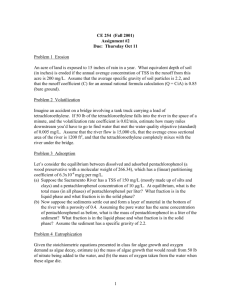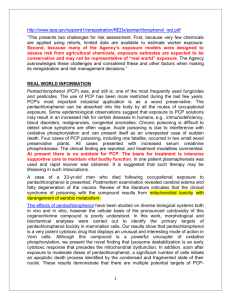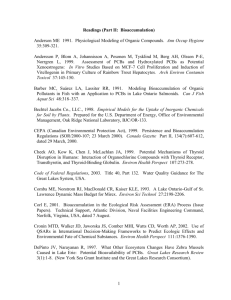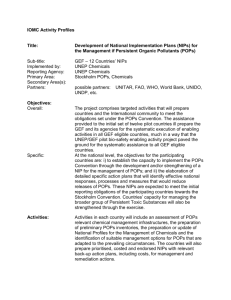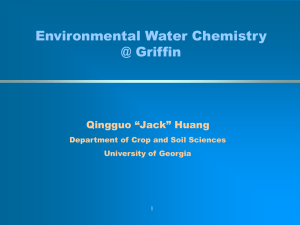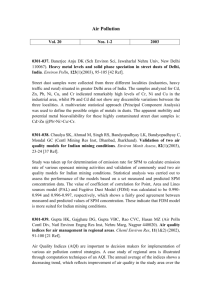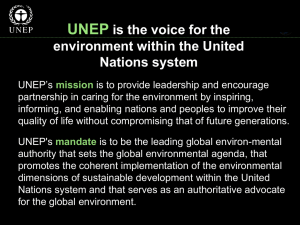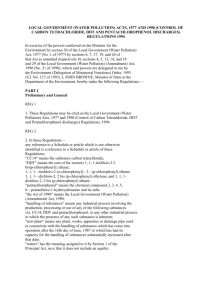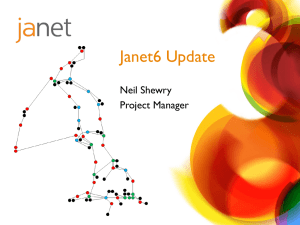Reference_List_for_Pentachlorophenol_Task_Force_Comment
advertisement
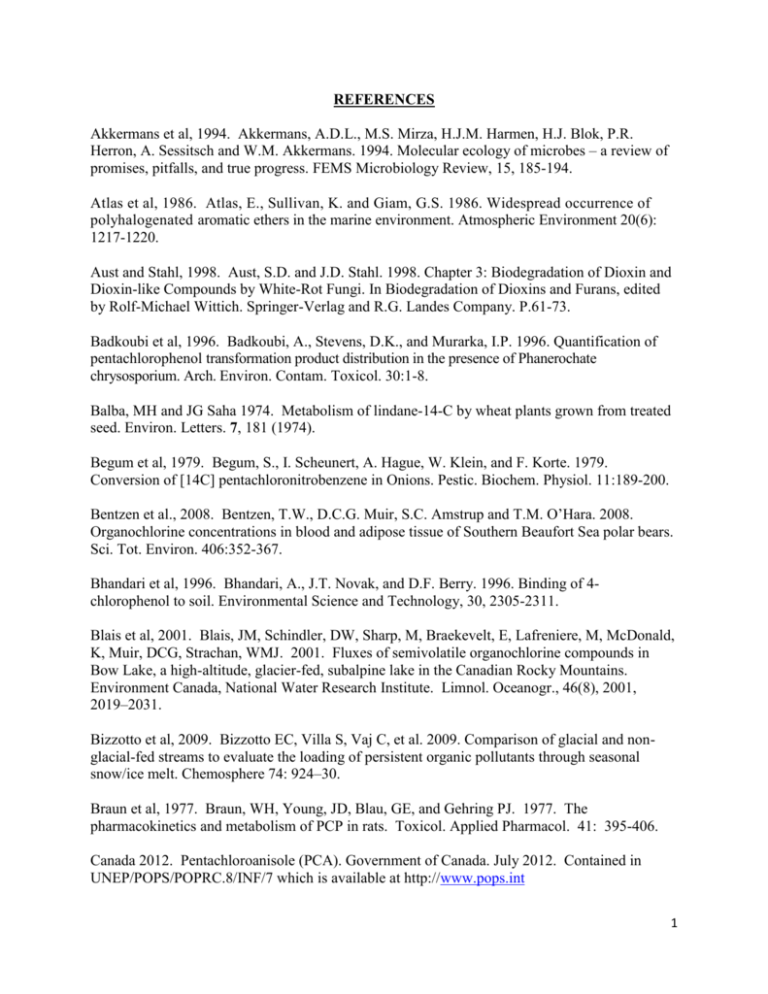
REFERENCES Akkermans et al, 1994. Akkermans, A.D.L., M.S. Mirza, H.J.M. Harmen, H.J. Blok, P.R. Herron, A. Sessitsch and W.M. Akkermans. 1994. Molecular ecology of microbes – a review of promises, pitfalls, and true progress. FEMS Microbiology Review, 15, 185-194. Atlas et al, 1986. Atlas, E., Sullivan, K. and Giam, G.S. 1986. Widespread occurrence of polyhalogenated aromatic ethers in the marine environment. Atmospheric Environment 20(6): 1217-1220. Aust and Stahl, 1998. Aust, S.D. and J.D. Stahl. 1998. Chapter 3: Biodegradation of Dioxin and Dioxin-like Compounds by White-Rot Fungi. In Biodegradation of Dioxins and Furans, edited by Rolf-Michael Wittich. Springer-Verlag and R.G. Landes Company. P.61-73. Badkoubi et al, 1996. Badkoubi, A., Stevens, D.K., and Murarka, I.P. 1996. Quantification of pentachlorophenol transformation product distribution in the presence of Phanerochate chrysosporium. Arch. Environ. Contam. Toxicol. 30:1-8. Balba, MH and JG Saha 1974. Metabolism of lindane-14-C by wheat plants grown from treated seed. Environ. Letters. 7, 181 (1974). Begum et al, 1979. Begum, S., I. Scheunert, A. Hague, W. Klein, and F. Korte. 1979. Conversion of [14C] pentachloronitrobenzene in Onions. Pestic. Biochem. Physiol. 11:189-200. Bentzen et al., 2008. Bentzen, T.W., D.C.G. Muir, S.C. Amstrup and T.M. O’Hara. 2008. Organochlorine concentrations in blood and adipose tissue of Southern Beaufort Sea polar bears. Sci. Tot. Environ. 406:352-367. Bhandari et al, 1996. Bhandari, A., J.T. Novak, and D.F. Berry. 1996. Binding of 4chlorophenol to soil. Environmental Science and Technology, 30, 2305-2311. Blais et al, 2001. Blais, JM, Schindler, DW, Sharp, M, Braekevelt, E, Lafreniere, M, McDonald, K, Muir, DCG, Strachan, WMJ. 2001. Fluxes of semivolatile organochlorine compounds in Bow Lake, a high-altitude, glacier-fed, subalpine lake in the Canadian Rocky Mountains. Environment Canada, National Water Research Institute. Limnol. Oceanogr., 46(8), 2001, 2019–2031. Bizzotto et al, 2009. Bizzotto EC, Villa S, Vaj C, et al. 2009. Comparison of glacial and nonglacial-fed streams to evaluate the loading of persistent organic pollutants through seasonal snow/ice melt. Chemosphere 74: 924–30. Braun et al, 1977. Braun, WH, Young, JD, Blau, GE, and Gehring PJ. 1977. The pharmacokinetics and metabolism of PCP in rats. Toxicol. Applied Pharmacol. 41: 395-406. Canada 2012. Pentachloroanisole (PCA). Government of Canada. July 2012. Contained in UNEP/POPS/POPRC.8/INF/7 which is available at http://www.pops.int 1 CDC, 2010. Centers for Disease Control and Prevention, National Report on Human Exposure to Environmental Chemicals, Chemical Information, Pentachlorophenol, (update April 13, 2010). http://www.cdc.gov/exposurereport/data_tables/Pentachlorophenol_ChemicalInformation.html Chi, J and Huang, G-L. 2002. Modeling a-water exchange process of pentachlorophenol in the Arctic environment. Water Qual. Res. J. Canada. 37: 445-458. Chung and Aust 1995. Chung, N. and S.D. Aust. 1995. Degradation of pentachlorophenol in soil by Phanerochaete chrysosporium. Journal of Hazardous Materials, 41, 177-183. Cookson, JT 1995. Bioremediation Engineering: Design and Application. McGrall Hill, New York, NY. Cserjesi, AJ, and Johnson, EL 1972. Methylation of pentachlorophenol byTrichoderma virgatum. Canadian Journal of Microbiology, 1972, 18(1): 45-49. D'Angelo, E.M. and Reddy, K.R. 2000. Aerobic and anaerobic transformations of pentachlorophenol in wetland soils. Soil Sci. Soc. Am. J. 64: 933-943. Dieke et al, 1947. Dieke SH, Allen GS, Richter CP [1947]. The acute toxicity of thioureas and related compounds to wild and domestic Norway rats. J Pharmacol Exp Ther 90:260-270. Debets and Stirk 1979. Debets, F. M. H., and J. J. T. W. A. Strik: An approach to elucidate the mechanism of hexachlorobenzene-induced hepatic porphyria, as a model for the hepatotoxicity of polyhalogenated aromatic compounds (PHA’s). In J. J. T. W. A. Strik, and J. H. Koeman (eds.): Chemical porphyria in man. Amsterdam, New York: Elsevier, North-Holland Biomedical Press (1979). de March et al, 1998. de March, B.G.E., de Wit, C.A., and Muir, D.C.G AMAP, 1998. AMAP Assessment Report: Arctic Pollution Issues. Arctic Monitoring and Assessment Programme (AMAP), Chapter 6 Persistent Organic Pollutants, Oslo, Norway. xii+859 pp. ECH 124. 1991. International Programme on Chemical Safety. Environmetnal Health Criteria 124. LINDANE. http://www.inchem.org/documents/ehc/ehc/ehc124.htm Eisler, R. 2002. Chapter 23: Pentachlorophenol. In Handbook of Chemical Risk Assessment: Health Hazards to Humans, Plant and Animals. Volume 2, Organics. Lewis Publishers. Engst et al, 1976. Engst, R; Macholz, RM; Kujawa, M; et al. (1976) The metabolism of lindane and its metabolites gamma-2,3,4,5,6-pentachlorocyclohexene, pentachlorobenzene, and pentachlorophenol in rats and the pathways of lindane metabolism. J Environ Sci Health B 11:95–117. Engst et al. 1979. Engst, R., Macholz, R.M. and M Kujawa. 1975. Recent State of lindane metabolism, Part II. Res Rev. 72, pp. 71-95. 2 Fernando et al, 1989. Fernando, T., S.D. Aust, and J.A. Bumpus. 1989. Effect of culture parameters on DDT [1,1,1-trichloro-2,2-bis(chlorophenyl)ethane], Chemosphere, 19, 1387-1398. Ford et al, 2007. Ford, C.I, Walter, M., Northcott, G.L., Dic, H.J., Cameron, K.C. and Trower. T. 2007. Fungal inoculum properties: extracellular enzyme expression and pentachlorophenol removal in highly contaminated field soils. J Environ Qual 36:1599-1608. Glickman et al, 1977. Glickman, A.H., Statham, C.N., Wu, A and Lech, J.J. 1977. Studies on the uptake, metabolism, and disposition of pentachlorophenol and pentachloroanisole in rainbow trout. Toxicology and Applied Pharmacology 41:649‐658. Gopalaswamy and Aiyar 1984. Gopalaswamy, U.V. and Aiyar, A.S. 1984. Biotransformation of lindane in the rat. Bull. Environ. Contam. Toxicol. 32:148-156. Haggblom, M.M., and L.Y. Young. 1990. Chlorophenol transformation coupled to sulfate reduction. Applied Environmental Microbiology, 56, 3255-3260. Haimi et al, 1993. Haimi J, Salminen J, Huhta V, Knuutinen J and Palm H. 1993 Chloroanisoles in soil and earthworms. Science of the Total Environment, supplement 1993: 439‐448 (1993). Hoberman, A.M. 1997. Oral (Gavage) Two-Generation (One Litter Per Generation) Reproduction Study of Pentachlorophenol in Rats. Study conducted by Argus Research Laboratories, Horsham, PA for the Pentachlorophenol Task Force, submitted under MRID 44464101. Hoekstra et al, 2003. Hoekstra, PF; Braune, BM; Wong, CS; Williamson, M; Elkin, B; Muir, DCG. 2003. Profile of persistent chlorinated contaminants, including selected chiral compounds, in wolverine (Gulo gulo) livers from the Canadian Arctic. Chemosphere 53, 551-560. Hoekstra et al, 2003. Hoekstra P, Letcher RJ, O’Hara TM, Backus SM, Soloman KR, and Muir DCG. (2003). Hydroxylated and methylsulfone-containing metabolites of polychlorinated biphenyls in the plasma and blubber of Bowhead whales. Environ. Toxicol. Chem. 22: 26502658. Hoferkamp et al, 2010. Hoferkamp, L. M.H. Hermanson, and D.C.G. Muir. 2010. Current use pesticides in Arctic media; 2000‐2007. Sci. Total Environ.408 (15): 2985-2994. Hung et al, 2005. Hung, H., P. Blanchard, C.J. Halsall, T.F. Bidleman, G. Stern, P. Fellin, D.C.G. Muir, L.A. Barrie, L.M. Jantunen, P.A. Helm, J. Ma and A. Konoplev; “Temporal and spatial variabilities of atmospheric polychlorinated biphenyls (PCBs), organochlorine (OC) pesticides and polycyclic aromatic hydrocarbons (PAHs) in the Canadian Arctic: Results from a decade of monitoring”; Sci. Tot. Environ. 342:119‐144 (2005). 3 Institute of Environmental Protection (IEP) dossier. 2008. Borysiewicz, M. “Risk Profile of Pentachlorophenol”, Institute of Environmental Protection. Warsaw, Poland, May 2008. http://www.unece.org/env/lrtap/TaskForce/popsxg/Documents%20for%20the%20meeting.htm It is also available as an information document to the POPRC-7 meeting. Please see UNEP/POPS/POPRC.7/INF/5 at www.pops.int IISD’s POPRC meeting summaries for the PORPC-7, 8, 9, and 10 meetings. Available at: http://www.iisd.ca/vol15/ Ikeda et al, 1994. Ikeda GJ, Sapienza PP and Warr PI., 1994. Disposition and metabolism of radiolabelled pentachloroanisole in rats and rabbits, Food and Chemical Toxicology; 32, 1137‐ 1146 (1994). Ikeda and Sapienza 1995. Ikeda, G.J. and P.P. Sapienza. 1995. Distribution, Metabolism and Excretion of Pentachloroanisole in the Beagle Dog and Miniature Pig. Food Chem. Toxic. 33 (5): 409-421. Koegel et al, 1979. KOEGEL, W., MULLER, W.F., COULSTON, F., & KORTE, F. (1979). Fate and effects of pentachloronitrobenzene in Rhesus monkeys. J. agric. food Chem., 27: 1181-1185. Koss et al, 1976. Koss, G., Koransky, W., and Steinbach, K. 1976. Studies on the toxicology of hexachlorobenzene, II. Identification and determination of metabolites. Arch. Toxicol. 35: 107-114. Kujawa et al, 1977. Kujawa M, Engst R, Macholz R (1977) On the metabolism of lindane. Environ Pollut Human Health, Proc Internatl Symp 1975:661-672. Kuwatsuka, S. and M. Igarashi. 1975. Degradation of PCP in soils. Soil Science and Plant Nutrition, 21, 405-414. Lamar, RT and Dietrich, DM 1990. In situ depletion of pentachlorophenol from contaminated soil by Phanerochaete spp. Applied and Environ. Microbiol. 56(10): 3093-3100. October 1990. Lamar et al, 1990. Lamar, R.T., M.J Larsen and T.K Kirk. 1990. Sensitivity to and degradation of pentachlorophenol by Phanerochaete spp. Applied Environmental Microbiology, 56(11). 3519-3526. November 1990. Leatham, GF and TK Kirk. 1983. Regulation of ligninolytic activity by nutrient nitrogen in white-rot basidiomycetes. FEMS Microbiology Letters, 16, 65-67. Machado et al, 2005. Machado, K.M.G., D.R. Matheus, R.T.R. Monteiro and V.L.R. Bononi. 2005. Biodegradation of pentachlorophenol by tropical basidiomycetes in soils contaminated with industrial residues. World Journal of Microbiology and Biotechnology, 21, 297-301. 4 Middeldrop et al, 1990. Middeldrop, P.J.M., M Briglia, and M. Salkinnoja-Salonen. 1990. Biotransformation of pentachlorophenol in natural soil by inoculated Rhodococcus chlorophenolicus. Microbiology Ecology, 20, 123-139. Mileski et al, 1988. Mileski, G.J., J.A. Bumpus, M.A. Jurek and S.D. Aust. 1988. Biodegradation of pentachlorophenol by the white-rot fungus Phanerochaete chrysosporium. Applied Environmental Microbiology, 54, 2885-2889. Mohn, W.W. and J.L. Tiedje. 1991. Evidence of chemiosmotic coupling of reductive dechlorination and ATP synthesis in Desulfomonile tiedjei. Archive of Microbiology, 157, 1-6. Muir et al, 1997. Muir, D.; Braune, B.; DeMarch, B.; Norstrom, R.; Wagemann, R.; Gamberg, M.; Poole, K.; Addison, R.; Bright, D.; Dodd, M.; Duschenko, W.; Eamer, J.; Evans, M.; Elkin, B.; Grundy, S.; Hargrave, B.; Herbert, C.; Johnstone, R.; Kidd, K.; Lockhart, L.; Payne, J.; Peddle, J.; Reimer, K. (1997) Ecosystem uptake and effects. In: Jensen, J.; Adare, K.; Shearer, R. (eds), Canadian Arctic Contaminants Assessment Report. Chapter 3. Ottawa, Indian and Northern Affairs, Canada. 191-294. Muller et al, 1978. Muller, W.F., Scheunert, I., Rozman, K., Kogel, W., Freitag, D., Richter, E., Coulston, F., and F., Korte (1978) Comparative metabolism of hexachlorobenzene in plants, rats and Rhesus monkeys. Ecotoxicol. Environ. Saf. 2: 437-445. Murthy et al., 1979. Murthy NBK, Kaufman DD and Fries GF., Degradation of pentachlorophenol (PCP) in aerobic and anaerobic soil. Journal of Environmental Science and Health ‐ Part B Pesticides, Food Contaminants, and Agricultural Wastes 14 (1): 1‐14 (1979). Murthy and Kaufman, 1978. Narra B. K. Murthy , Donald D. Kaufman, Degradation of pentachloronitrobenzene (PCNB) in anaerobic soils , J. Agric. Food Chem., 1978, 26 (5), pp 1151–1156. NARAP. 2006. The North American Regional Action Plan (NARAP) on Lindane and Other Hexachlorocyclohexane (HCH) Isomers. Commission for Environmental Cooperation. 30 November 2006. http://www.cec.org/Storage/36/2797_NARAP_on_Lindane_and_Other_Hexachlorocyclohexane_Isomers.pdf NTP. 1993. NTP Toxicology and Carcinogenesis Studies of Pentachloroanisole (CAS No. 182521-4) in F344 Rats and B6C3F1 Mice (Feed Studies). Natl Toxicol Program Tech Rep Ser. 414:1-284. Oliver and Niimi 1985. Oliver, BG and AJ Niimi. “Bioconcentration Factors of Some Halogenated Organics for Rainbow Trout: Limitations in Their Use for Prediction of Environmental Residues”. Environ. Sci. Technol. 19 (9) 842-849 (1985). Opperhuizen, A. and P.I. Voors. 1987. Uptake and elimination of polychlorinated aromatic ethers by fish: chloroanisoles. Chemosphere, 16, 953-962. 5 Rayner, ADM and L Boddy. 1988. Fungal Decomposition of Wood, Its Biology and Ecology, John Wiley and Sons, Inc., New York, NY. Renner, G. 1981. Biotransformation of the fungicides hexachlorobenzene and pentachloronitrobenzene. Xenobiotica 11(7): 435-446. Renner et al, 1986. “Acute toxicities of pentachlorophenol, pentachloroanisole, tetrachlorohydroquinone, tertrachlorocatechol, tetrachlororesorcinol and tertrachlorobenzendiol diacetates administered to mice”; Tox Environ Chem 11 (1): 37-50 (1986). Renner, G. 1988. Hexachlorobenzene and its Metabolism. Toxicol. Environ. Chem. 18, 51-78. Rostad et al, 1999. Rostad, C.E., Pereira, W.E. and Leiker T.J. 1999. Distribution and transport of selected anthropogenic lipophilic organic compounds associated with Misssissippi River suspended sediment, 1989‐1990. Arch. Environ. Contam. Toxicol. 36:248‐255 (1999). Rüttimann-Johnson, C. and Lamar, R.T. 1996. Polymerization of pentachlorophenol and ferulic acid by fungal extracellular lignin-degrading enzymes. Applied and Environmental Microbiology, 62, 3890 3893. Rüttimann-Johnson, C. and Lamar, R.T. 1997. Binding of pentachlorophenol to humic substances in soil by the action of white-rot fungi. Soil Biology and Biochemistry, 29, 1143 1148. Schmitt et al, 1990. Schmitt CJ, Zajicek JL and Peterman PH. (1990) National Contaminant Biomonitoring Program: Residues of Organochlorine Chemicals in U.S. Freshwater Fish, 1976‐ 1984. Archives of Environmental Contamination and Toxicology 19: 748‐781. Schreitmüller, J and Ballschmiter, K. 1995. “Air‐water equilibrium of hexachlorocyclohexanes and chloromethoxybenzenes in north and south Atlantic”; Environ. Sci. Technol. 29: 207‐215. Siekel et al, 1991: Siekel, P, Chalupa, I, Beno, J, Blasko, M, Novotny, J, Burian, J. 1991. “A Genotoxicological Study of Hexachlorobenzene and Pentachloroanisole”. Institute of Biochemistry and Biotechnology, Komensky University, Bratislava (PS., J.B., J.B.); and Cancer Research Institute, Slovak Academy of Sciences, Bratislava (I. C., M.B.); Slovak Trade Inspection, Bratislava (J.N.), Czechoslovakia. Teratogenesis, Carcinogenesis, and Mutagenesis 1155-60 (1991). Su et al, 2008. Su Y., Hung H, Blanchard P, Patton G, Kallenborn R, Konoplev A, Fellin P, Green C, Stern G, Rosenberg B, and Barrie L (2008). A circumpolar perspective of atmospheric organochlorine pesticides (OCPs): Results from six Arctic monitoring stations in 2000-2003; Atmospheric Environment, 42 (19), pp. 4682-4698. Suzuki, T 1983. Methylation and hydroxylation of Pentachlorophenol by Mycobacterium sp. Isolated from Soil. Journal of Pesticide Science 8: 419-428. Suthersan, S. 1997. Remediation Engineering Design Concepts, CRC Press, Boca Raton, FL. 6 Swackhamer, DL and RA Hites, 1988. Occurrence and bioaccumulation of organochlorine compounds in fishes from Siskiwit Lake, Isle Royale, Lake Superior. Environ. Sci. Technol. 22, 543-548. Swackhamer et al, 1988. Swackhamer, D.L., B.V. McVeety, and R.A. Hites. 1988. Deposition and evaporation of PCB congeners to and from Siskiwit Lake, Isle Royale. Environ. Sci. Technol. 22, 664-672. To-Figueras et al, 1997. To-Figueras, J., Sala, M., Otero, R., Barrot, C., Santiago-Silva, M., Rodamilans, M., Herrero, C., Grimalt, J., and Sunyer, J. 1997. Metabolism of hexachlorobenzene in humans: Association between serum levels and urinary metabolites in a highly exposed population. Environmental Health Perspectives 105(1): 78-83. Torres et al, 1996. Torres Mora, R., C. Grosset, R. Steiman and J. Alary. 1996. Liquid chromoatography study of degradation and metabolism of pentachloronitrobenzene by four soil micromycetes. Chemosphere 33: 683-692. UNECE Addendum 2010. Addendum for PCP. BiPro GmbH, May, 2010. http://www.unece.org/fileadmin/DAM/env/lrtap/TaskForce/popsxg/2010/Updated%20documetn s_June2010/Addendum%20PCP_100520%20final.pdf UNEP Stockholm Convention. Meeting documents before the POPs Review Committee (POPRC). Available at www.pops.int POPRC-7 meeting: Meeting report: UNEP/POPS/POPRC.7/19 Additional information on pentachlorophenol and its salts and esters: UNEP/POPS/POPRC.7/INF/5/Add.1 POPRC-8 meeting: Meeting report: UNEP/POPS/POPRC.8/16 including the POPRC Decision POPRC-8/4: Pentachlorophenol and its salts and esters, [Section C.5] Information on pentachlorophenol and its salts and esters: UNEP/POPS/POPRC.8/INF/7 POPRC-9 meeting: Meeting report: UNEP/POPS/POPRC.9/13 Final Risk Profile: UNEP/POPS/POPRC.9/13/Add.3 Intersessional comments on the draft Risk Profiles: UNEP/POPS/POPRC.9/INF/9 POPRC-10 meeting: Meeting report: UNEP/POPS/POPRC.10/10 Final Risk Management Evaluation: UNEP/POPS/POPRC.10/10/Add.1 Intersessional comments on the draft Risk Management Evaluations: UNEP/POPS/POPRC.10/INF/4 Reissued for technical reasons on 3 October 2012. 7 Uotila et al, 1995. Uotila, J.S., V.H. Kitunen, T. Coote, T. Saastamoinen, M. Salkinoja-Salonen, and J.H.A. Apajalahti. 1995. Metabolism of halohydroquinones in Rhodococcus chlorophenolicus PCP-1. Biotransformation, 6, 119-126. U.S. EPA (Environmental Protection Agency). (2006a) Reregistration Eligibility Decision for Pentachloronitrobenzene; EPA OPP-2006-XXX, available online at http://www.epa.gov/opp00001/chem_search/reg_actions/reregistration/red_PC-056502_11-Jul06.pdf. U.S. EPA (Environmental Protection Agency). (2006b) An inventory of sources and environmental releases of dioxin like compounds in the United States for the years 1987, 1995, and 2000. National Center for Environmental Assessment, Washington, DC; EPA/600/P03/002F. Van Elsas, J.D. and C.E. Heijnen. 1990. Methods for the introduction of bacteria into soil – a review. Biology and Fertilization of Soils, 10, 127-133. Van Ommen et al, 1985. Van Ommen, B., van Bladeren, P.J., Temmink, J.H.M., and Muller, F. 1985. Formation of pentachlorophenol as the major product of microsomal oxidation of hexachlorobenzene. Biochemical and Biophysical Research Communications 126(1): 25-32. Van Ommen et al, 1986. Van Ommen, B., Adang, A.E.P., Brader, L, Posthumus, M.A., Muller, F. amd van Bladeren, P.J. 1986. The microsomal metabolism of hexachlorobenzene. Biochemcial Pharmacology 35(19): 3233-3238. Van Raaij et al, 1993. Van Raaij, J.A.G.M., Frijters, C.M.G., and van den Berg, K.J. 1993. Hexachlorobenzene-induced hypothyroidism: Involvement of different mechanisms by parent compound and metabolite. Biochemical Pharmacology 46(8): 1385-1391. Van Veem et al, 1997. Van Veem, J.A., L.S. Overbeek and J.D. Van Elsas. 1997. Fate and activity of microorganisms introduced into soil. Microbiology and Molecular Biology Reviews. 61, 121-135. Vodicnik et al. 1980. Vodicnik, M.J., Glickman, A.H., Rickert, D.E. and Lech, J.J., 1980. Studies on the Disposition and Metabolism of Pentachloroanisole in Female Mice. Toxicology and Applied Pharmacology 56: 311-316. Vorkamp et al, 2003. Vorkamp, K.; Christensen, J.H.; Glasius, M.; Riget, F.F. 2003. Persistent halogenated compounds in black guillemots (Cepphus grylle) from Greenland – levels, compound patterns and spatial trends. Mar. Pollut. Bull. ASAP page. Vorkamp et al, 2004. Vorkamp K, Riget F, Glasius M, Pécseli M, Lebeuf M and Muir D. 2004. Chlorobenzenes, chlorinated pesticides, coplanar chlorobiphenyls and other organochlorine compounds in Greenland biota. Sci. Total Environ. 331: 157–175 8 Walter et al, 2005. Walter, M., K. Boyd-Wilson, L. Boul, C. Ford, D. McFadden, B. Chong and J. Pinfold. 2005. Field-scale bioremediation of pentachlorophenol by Trametes versicolor. International Biodeterioration and Biodegradation, 56, 51-57. Weber et al, 2006. Weber J, Halsall CJ, Muir DCG, Teixeira C, Burniston DA, Strachan WMJ, Hung H, MacKay N, Arnold D and H. Kylin. 2006. Endosulfan and γ-HCH in the arctic: An assessment of surface seawater concentrations and air-sea exchange. Environ. Sci. and Technol. 40(24): 7570-7576. Weiss et al, 1982. Weiss, U.M., I. Scheunert, W. Klein and F. Korte. 1982. Fate of pentachlorophenol-14C in soil under controlled conditions. J. Agric. Food Chem. 30:1191-1194. Xun et al, 1992. Xun, L., E. Topp and C.S. Orser. 1992. Purification and characterization of a tetrachloro-p-hydroquinone reductive dehalogenase from a Flavobacterium sp. Journal of Bacteriology, 174, 8003-8007. Yuan et al, 1993. Yuan JH, Goehl TJ, Murrill E, Moore R, Clark J, Hong L, and Irwin R. 1993. Toxicokinetics of pentachloroanisole in F344 rats and B6C3F1 mice. Xenobiotica 23 (4): 42738. Zhang, X. and J. Wiegel. 1990. Sequential anaerobic transformation of 2,4-dichlorophenol in freshwater sediments. Applied Environmental Microbiology, 56, 1119-1127. 9
